
Pachypodium is a genus of succulent spine-bearing trees and shrubs, native to Madagascar and Africa. It belongs to the family Apocynaceae.
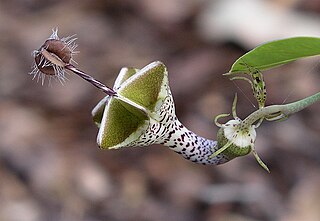
Ceropegia is a genus of plants within the family Apocynaceae, native to Africa, southern Asia, and Australia. It was named by Carl Linnaeus, who first described this genus in his Genera plantarum, which appeared in 1737. Linnaeus referred to the description and picture of a plant in the Horti Malabarici as the plant for which the genus was created. In 1753 he named this species as Ceropegia candelabrum. Linnaeus did not explain the etymology but later explanations stated that the name Ceropegia was from the Greek word keropegion κηροπηγɩον. This means candelabrum in Latin, which has a broader range than the modern word - "a candlestick, a branched candlestick, a chandelier, candelabrum, or also lamp-stand, light-stand, sometimes of exquisite workmanship".

Hoodia is a genus of flowering plants in the family Apocynaceae, under the subfamily Asclepiadoideae, native to Southern Africa.

Stapeliinae is a subtribe of flowering plants within the tribe Ceropegieae of the subfamily Asclepiadoideae of the family Apocynaceae. The subtribe comprises about 35 genera, including both the stem-succulent "stapeliads" and the horticulturally popular genera Brachystelma and Ceropegia. The largest number of genera are native to Africa, but a more limited number of genera are widespread in Arabia and Asia. Historically, a similarly circumscribed taxon was treated as a separate tribe, Stapelieae.
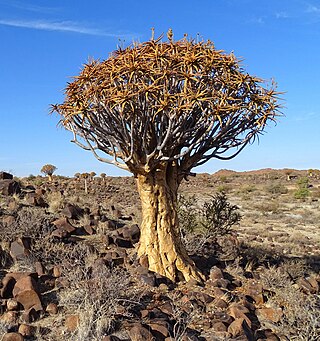
Aloidendron dichotomum, formerly Aloe dichotoma, the quiver tree or kokerboom, is a tall, branching species of succulent plant, indigenous to Southern Africa, specifically in the Northern Cape province of South Africa, and parts of Southern Namibia.
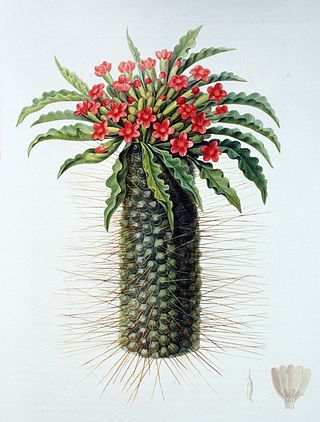
Pachypodium namaquanum, also known as halfmens or elephants trunk, is a succulent plant of Southern Africa. The genus name Pachypodium is from the Greek for 'thick foot', an allusion to its swollen base, while the species name namaquanum is a reference to Namaqualand.
Marlothiella gummifera is a species of flowering plant in the family Apiaceae, and the only species in the monotypic genus Marlothiella. It is endemic to Namibia, where its natural habitats are rocky areas and cold desert. It is also the only genus in the tribe Marlothielleae, of the subfamily Apioideae.
Australluma peschii is a species of plant in the family Apocynaceae. It is native to Angola and Namibia. Its natural habitat is dry savanna. It is threatened by habitat loss.
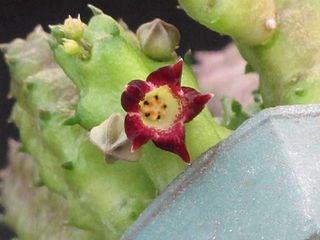
Baynesia is a genus of flowering plants in the family Apocynaceae. Its only species is Baynesia lophophora, endemic to Namibia. It was first discovered by Peter Bruyns in 1999, and first described by him in 2000.
Ceropegia dinteri is a species of plant in the family Apocynaceae. It is endemic to Namibia. Its natural habitats are subtropical or tropical dry shrubland and rocky areas.

Hoodia juttae is a species of plant in the family Apocynaceae. It is endemic to Namibia. Its natural habitats are rocky areas and cold desert. H. juttae is found around the Little and Great Karas mountains. It is threatened by collection. The plant was discovered by Jutta Dinter, the wife of botanist, Kurt Dinter in 1913. The scientific name refers to Jutta.

Hoodia ruschii is a species of stem succulent plant in the family Apocynaceae. It is endemic to Namibia. Its natural habitats are rocky areas and cold desert.
Hoodia triebneri is a species of plant in the family Apocynaceae. It is endemic to Namibia. Its natural habitat is rocky areas, especially underneath Acacia trees and below ridges.

Lavrania is a monospecific genus of plants in family Apocynaceae. Its only species is Lavrania haagnerae, endemic to Namibia. Its natural habitat is rocky areas.
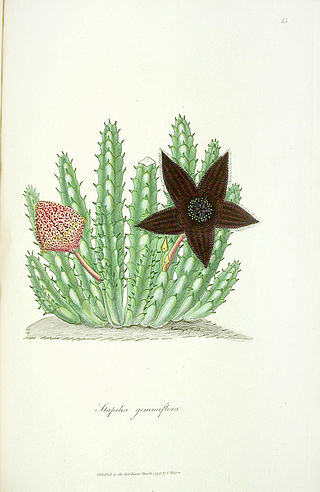
Tridentea is a genus of succulent plant in the family Apocynaceae, endemic to southern Africa.

Vachellia reficiens, commonly known as red-bark acacia, red thorn, false umbrella tree, or false umbrella thorn, is a deciduous tree or shrub of the pea family (Fabaceae) native to southern Africa, often growing in an upside-down cone shape and with a relatively flat crown.

Pachydactylus atorquatus, also known commonly as the Augrabies gecko and Good's gecko, is a species of thick-toed gecko, a lizard in the family Gekkonidae. The species is native to southern Africa.

Stapelianthus is a genus of flowering plants in the family Apocynaceae, first described as a genus in 1933. The entire genus is endemic to Madagascar and is concentrated in the far south of the island.

Diplorhynchus is a monotypic genus of plant in the family Apocynaceae native to tropical and southern Africa. As of August 2020, Plants of the World Online recognises the single species Diplorhynchus condylocarpon.
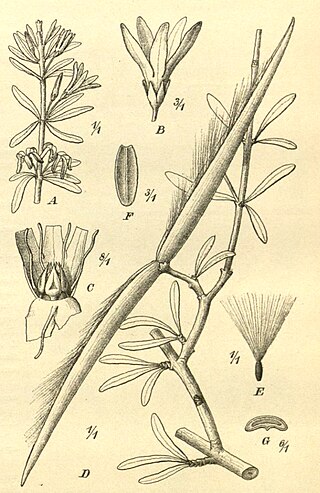
Cryptolepis decidua is a species of plant in the Apocynaceae family. It is native to Angola, Botswana, Namibia, and South Africa. George Bentham, the botanist who first formally described the species, named it after its falling leaves that leave behind overlapping persistent petiole bases.
















